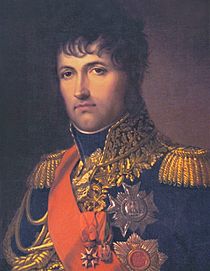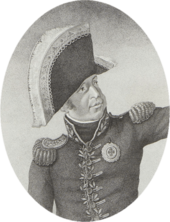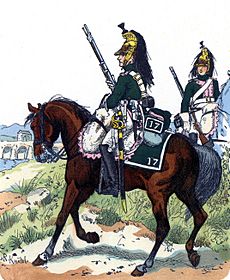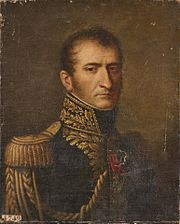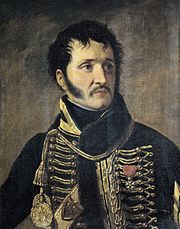Battle of Braga (1809) facts for kids
Quick facts for kids Battle of Braga (1809) |
|||||||
|---|---|---|---|---|---|---|---|
| Part of the Peninsular War | |||||||
 North is to the right in this Battle of Braga map. |
|||||||
|
|||||||
| Belligerents | |||||||
| Commanders and leaders | |||||||
| Strength | |||||||
| 16,000–16,650, 12 guns | 23,000–25,000, 18 guns | ||||||
| Casualties and losses | |||||||
| 200–600 | 4,400, 17 guns | ||||||
The Battle of Braga was a fight that happened on March 20, 1809. It was part of the Peninsular War, a big conflict in Europe. In this battle, French soldiers led by Marshal Nicolas Soult fought against a Portuguese army. The Portuguese army was commanded by Baron Eben.
When the skilled French soldiers attacked, the Portuguese fought back at first. But soon, they started to run away. Many Portuguese soldiers were killed. Most of them were not well-trained or well-armed. This battle was part of the second time France invaded Portugal.
After the Battle of Corunna, where the British army left Spain, Marshal Soult decided to invade Portugal. His troops had to fight many Spanish guerillas (small groups of fighters) on their way. They crossed into Portugal in early March 1809. After taking the town of Chaves, Soult's army met a large group of Portuguese fighters. These fighters had just killed their own commander. The French won easily, but the Portuguese continued to resist. Meanwhile, another Portuguese army was getting ready to defend the city of Porto.
Braga is a city located about 45 kilometers (28 miles) north-northeast of Porto.
Contents
Background to the Battle
The Battle of Braga marked the start of the Second Portuguese campaign. This was when France tried to invade Portugal for the second time.
Events in Northwest Spain
The British army won a small victory against Soult's French army at the Battle of Corunna on January 16, 1809. This win helped the British army leave Corunna safely. Emperor Napoleon ordered Soult to invade Portugal right after the British left. At that time, only 8,000 British soldiers were in Portugal. The Portuguese army was also just starting to rebuild.
Soult's army had about 43,000 soldiers. But 8,000 of them were guarding supply lines. Another 10,000 were sick. Napoleon wanted Soult to capture Porto by February 1 and Lisbon by February 10. This was a very difficult goal to achieve. While Soult went into Portugal, another French army, led by Michel Ney, stayed in Galicia, Spain.
Soult's forces took control of Ferrol on January 26, 1809. They captured many Spanish prisoners and military supplies. Soult then moved his troops south. Some towns, like Vigo and Tui, quickly surrendered. But the flooded Rio Minho river blocked their path. Soult's army had to go upstream towards Ourense. The roads were bad, and Spanish guerilla fighters constantly attacked the French.
Soult's troops stopped at Ourense for nine days to find food. But the French soldiers' actions made the local people even more determined to fight. From Ourense, Soult's army marched towards Chaves, Portugal. They hoped to defeat a Spanish army led by Pedro Caro, 3rd Marquis of la Romana. However, Romana quickly moved his troops east. On March 6, French cavalry caught Romana's rear guard. They defeated the Spanish soldiers, killing many and capturing others. On March 9, Soult's army crossed into Portugal.
French Invasion of Portugal
At Chaves, a Portuguese leader named Francisco Silveira gathered about 12,000 men. Half of them had guns, and the rest had pikes or farm tools. After two small fights that went badly for the Portuguese, Silveira ordered his men to leave Chaves. He wanted them to go to a safer place south of the town.
However, the angry crowd thought Silveira was a traitor. They almost killed him. Many decided to stay and defend Chaves against his orders. On March 10, 3,000 men and 1,200 armed citizens barricaded themselves inside Chaves. They chose an engineer officer to lead them. Silveira and his 7,000 men wisely retreated. The next day, the Portuguese defending Chaves surrendered easily. Soult sent most of the armed citizens and militiamen home. He forced 500 regular soldiers to join a French-controlled group. Most of these soldiers deserted later.
Soult left 1,325 sick soldiers at Chaves. He then marched on March 14 with his cavalry and infantry. The rest of his army followed behind him. Soult's main forces took a road west, through the mountains. They passed through Ruivães and Salamonde, then entered the plains near Braga. French scouts found that the Portuguese had only a few men guarding the mountain passes.
The Battle of Braga
French Approach to Braga
Bernardim Freire de Andrade commanded the Portuguese army near Braga. His army had about 23,000 to 25,000 men and 18 cannons. The best-armed troops were from the Loyal Lusitanian Legion and the Braga militia. The rest were mostly ordenanza, a type of local militia. About 5,000 of them had firearms, 11,000 had pikes, and the others had farm tools.
This large group of fighters held a position about 6 kilometers (4 miles) long on a ridge east of Braga. Freire made a mistake by keeping his main force near Braga. He only put small groups of fewer than 100 men to defend the mountain passes. The only exception was Salamonde, where Freire placed 300 regular soldiers.
A French officer wrote that if the Portuguese had good leaders, the French would have had to retreat. Instead, individual homeowners and groups of villagers, including young women, fought very bravely. French soldiers who got separated from their units were often killed. Despite this strong resistance, the French forces reached the main Portuguese defenses on March 17.
Meanwhile, Antonio de Castro, the Bishop of Porto, was a strong Portuguese patriot. He had great power in Porto. He called up many ordenanza, but he could not properly arm or control them. The British government sent Baron Eben and Friedrich von der Decken as military advisors. Robert Wilson also arrived and started the Loyal Lusitanian Legion. However, Wilson soon realized the bishop wanted to use this new unit as his personal guards. So, Wilson and about 1,500 troops went to defend the fortress of Almeida. Eben then took command of the 2nd Battalion. When Freire asked for help, the bishop only sent Eben and his battalion to Braga.
The Battle Begins
The Portuguese army's left side and center were on a high area called Monte Adaufé. The main road went through a small village called Carvalho d'Este, over Monte Adaufé, and into Braga. The Portuguese right side defended Monte Vallongo, which was even higher. As the French soldiers approached, Freire became worried. He started sending his army's heavy equipment and cannons to the rear. Freire wanted to retreat to Porto, but his men wanted to fight. So, he decided to stay and had his troops dig defenses near the road on Monte Adaufé.
The ordenanza who had fought at Salamonde came to the camp. They loudly accused Freire of being a coward. The soldiers became disobedient and threatened to kill their leader.
On March 17, Freire tried to sneak away from his army. But some ordenanza caught him and brought him back as a prisoner. Eben spoke to the soldiers, took command of the army, and had Freire put in the Braga jail. Soon after, a group of ordenanza went to Braga. They dragged Freire out of jail and killed him with their pikes. They also killed the army's chief engineer and at least one of Freire's officers. The soldiers also jailed the chief judge of Braga and other citizens they thought were traitors. Eben seemed to allow these actions, but the soldiers were out of control.
By the morning of March 20, almost all of Soult's army was ready. The French had about 13,000 infantry and 3,000 cavalry, with 12 cannons. Knowing he faced an army of mostly untrained fighters, Soult decided to attack head-on. He believed the Portuguese would break apart quickly.
When the French infantry advanced, the Portuguese cheered loudly and fired many shots. But this caused few French casualties. The Portuguese held their ground as the French climbed the hill. But as the French reached the top, the Portuguese defenders began to waver and run away. Eben reported that the retreat started when one of the Portuguese cannons exploded. Then, French cavalry charged into the fleeing Portuguese. An officer wrote that they "made a great butchery of them," cutting down the Portuguese as they ran through Braga and beyond. The French cavalry captured cannons, supplies, and the Portuguese army's money. During the chaos, some ordenanza found time to kill the citizens who were locked up in the city jail.
French troops also pushed back their opponents on another part of the battlefield. But without cavalry to chase them, the Portuguese lost fewer men there. Some defenders even regrouped briefly. But when more French soldiers arrived, the Portuguese ran away again.
The French soldiers attacking the Portuguese right side had a longer climb. By the time they reached the top of Monte Vallongo, the rest of Eben's army was already running away. Resistance here was even weaker. French horsemen charged into their fleeing enemies, killing many. After being chased for about 5 kilometers (3 miles), a group of militia with four cannons was trapped near the village of Falperra. French cavalry stopped them from escaping until more French infantry arrived. This resulted in many trapped Portuguese being killed. An officer wrote, "The commencement was a fight, the end a butchery."
Results of the Battle
Soult reported that 4,000 Portuguese soldiers were killed and 400 were captured. The French also captured 17 cannons and 5 flags. Soult said the French lost 40 killed and 160 wounded. Other estimates suggest French losses were around 400 to 600. One French witness noted that his soldiers only spared those in uniform and killed others. Historians explain the high number of Portuguese killed compared to prisoners. They suggest French soldiers were very angry from constant attacks by snipers and ambushes. Still, they say there was no good reason for so many Portuguese to be killed, as French losses were light. Eben reported that he lost only 1,000 men, including over 200 from the Loyal Lusitanian Legion.
The French first thought that this big defeat would stop the guerilla warfare. But they were wrong. While many Portuguese survivors went home, a large force gathered again behind the Ave River. They prepared to defend its crossings. Portuguese forces stopped Soult's army from contacting Tui in Spain. Silveira's troops also attacked French supply convoys between Braga and Chaves. Soult allowed his troops three days of rest in Braga. He then sent his cavalry to scout the area towards the Ave River. Leaving some troops to hold Braga and guard his sick and wounded, Soult marched south.
Aftermath
The next big battle in the Second Portuguese campaign between the French and Portuguese was the First Battle of Porto on March 29, 1809.
French Army Units
Here are the main French army units that fought in the Battle of Braga:
| Division | Strength | Regiment | Battalions/Squadrons |
|---|---|---|---|
| 2nd Division: General of Division Julien Augustin Joseph Mermet |
5,400 | 4 | |
| 4 | |||
| 4 | |||
| 1 | |||
| 1 | |||
| 1 | |||
| 3rd Division: General of Division Henri François Delaborde |
5,800 | 3 | |
| 3 | |||
| 3 | |||
| 3 | |||
| 4th Division: General of Division Étienne Heudelet de Bierre |
3,000 | 1 | |
| 1 | |||
| 2 | |||
| 2 | |||
| 1 | |||
| 1 | |||
| 1 | |||
| 1 | |||
| Corps Light Cavalry Division: General of Division Jean Baptiste Franceschi |
1,250 | 4 | |
| 4 | |||
| 4 | |||
| 4 | |||
| 3rd Dragoon Division: General of Division Armand Lebrun de La Houssaye |
1,200 | 4 | |
| 4 | |||
| 4 | |||
| 4 | |||
| 4th Dragoon Division: General of Division Jean Thomas Guillaume Lorge |
4 | ||
| 4 |
See also


